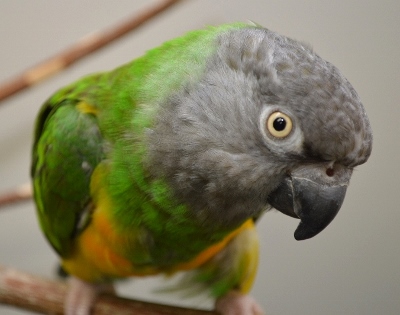
Can you believe the first month of 2018 is almost over already? Neither can we! And as the month wraps up, so too does our time with the Senegal parrot as January’s Animal of the Month on Twitter @ExoticPetVets. Here is a summary of our tweets in case you missed any during the month. Did you know?:
- The Senegal parrot (Poicephalus senegalus) is native to the large savanna woodland belt of west and central Africa – including Senegal, of course!
- In the wild, Senegal parrots migrate within part of their natural range during the wet season in favour of finding drier areas.
- Senegal parrots will also migrate based on food availability. In the wild, they will feed on fruits, blossoms and seeds. But farmers consider them to be pests as they will also eat millet and corn.
- Senegal parrots are a medium-sized parrot. They have stocky bodies and short tails and they sport simple striking colours.
- Senegal parrots have dark grey heads and beaks, which are a bit large relative to their body size. They have bright green feathers on the wings, back, throat and chest. Their thighs and underparts are orange-yellow in colour in a “V” pattern.
- There are no obvious external differences between male and female Senegal parrots, meaning they are not considered sexually dimorphic. But there are some bird enthusiasts who speculate that females have a longer “V” shape than males.
- Senegal parrots are social birds by nature and can be seen in the wild in pairs and small flocks.
- If they’re socialized well, Senegal parrots in captivity can be charming, sweet and very friendly birds. They enjoy engaging with their families in captivity.
- Senegal parrots are known to be very loyal. In captivity, they have a tendency to bond with one person in the family and may not want to interact with other people.
- While socializing a Senegal parrot, it’s important to have all family members interact with the bird so she doesn’t bond only with one person.
- Senegal parrots in captivity who bond with one human member of the family can get possessive of that person and exhibit jealous behaviour and aggression towards other members of the family, including other pets.
- Senegal parrots are intelligent and love to play and chew. In captivity, they should be provided with lots of bird-safe toys to prevent boredom.
- Senegal parrots are energetic birds and those in captivity enjoy playing on swings and ladders. They also need at least an hour a day outside of their cages to play in a bird safe area, which helps their physical fitness.
- With an independent nature, Senegal parrots are able to entertain themselves. But those in captivity do need daily interaction with the human members of their family.
- By parrot standards, Senegal parrots are relatively quiet birds. While they do like to chatter, their voices are quieter and more gentle than many larger parrots.
- Senegal parrots are able to mimic human speech and can have moderate vocabularies. They will also readily learn to mimic sounds around them; such as a beeping microwave, barking dog or ringing phone.
- Senegal parrots live an average of 25-30 years, but with proper care in captivity, they can live as long as 50 years.

